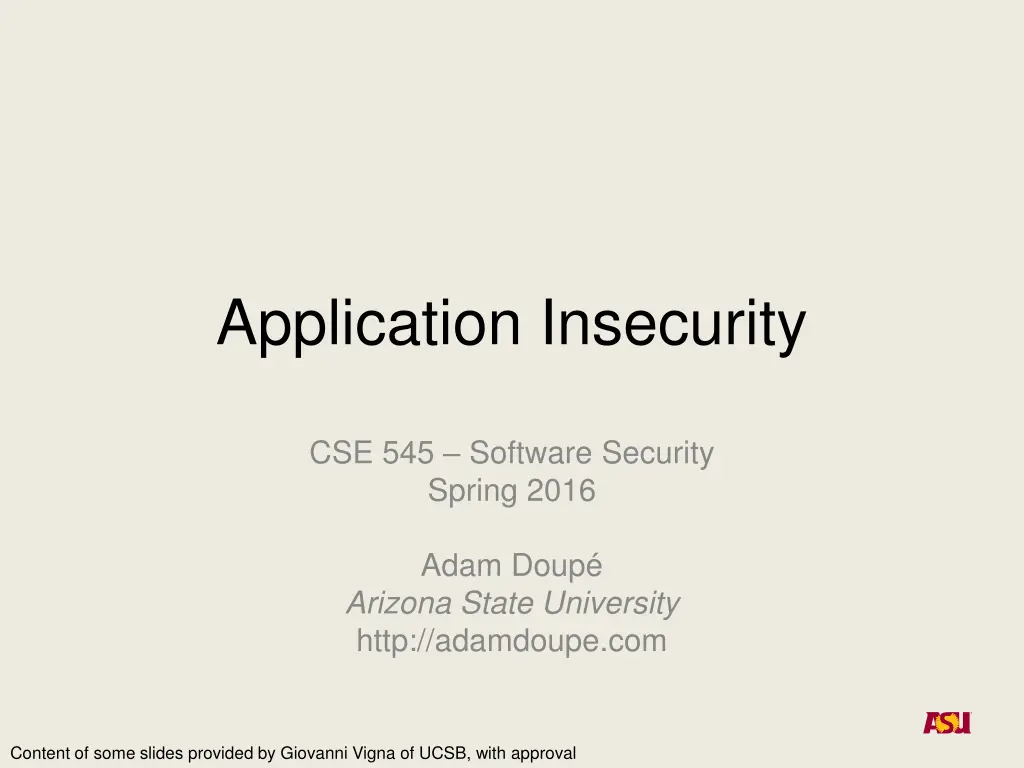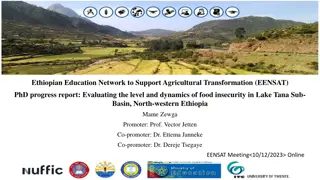
Understanding Application Security: Vulnerabilities and Analysis
Explore the world of application security with insights on various vulnerabilities such as design, implementation, and deployment weaknesses. Learn how to conduct application vulnerability analysis to identify and mitigate potential risks that can compromise system security and integrity.
Download Presentation

Please find below an Image/Link to download the presentation.
The content on the website is provided AS IS for your information and personal use only. It may not be sold, licensed, or shared on other websites without obtaining consent from the author. If you encounter any issues during the download, it is possible that the publisher has removed the file from their server.
You are allowed to download the files provided on this website for personal or commercial use, subject to the condition that they are used lawfully. All files are the property of their respective owners.
The content on the website is provided AS IS for your information and personal use only. It may not be sold, licensed, or shared on other websites without obtaining consent from the author.
E N D
Presentation Transcript
Application Insecurity CSE 545 Software Security Spring 2016 Adam Doup Arizona State University http://adamdoupe.com Content of some slides provided by Giovanni Vigna of UCSB, with approval
Application Security Applications provide services Locally (word processing, file management) Remotely (network services) The behavior of an application is determined by the code being executed, the data being processed, and the environment in which the application is run Attacks against applications aim at bringing applications to execute operations that violate the security of the system Violation of confidentiality Violation of integrity Violation of availability Adam Doup , Software Security
Application Model Environment Process Application Terminal OS Network File System Adam Doup , Software Security
Application Vulnerability Analysis Application vulnerability analysis is the process of identifying vulnerabilities in applications, as deployed in a specific operational environment Design vulnerabilities Implementation vulnerabilities Deployment vulnerabilities Adam Doup , Software Security
Design Vulnerabilities These vulnerabilities are flaws in the overall logic of the application Lack of authentication and/or authorization checks Erroneous trust assumptions These vulnerabilities are the most difficult to identify automatically because they require a clear understanding of the functionality implemented by the application The Confused Deputy problem Adam Doup , Software Security
Implementation Vulnerabilities These vulnerabilities are introduced because the application is not able to correctly handle unexpected events Unexpected input Unexpected errors/exceptions Unexpected interleaving of events Unfiltered output Adam Doup , Software Security
Deployment Vulnerabilities These vulnerabilities are introduced by an incorrect/faulty deployment/configuration of the application An application is installed with more privileges than the ones it should have An application is installed on a system that has a faulty security policy and/or mechanism (e.g., a file that should be read-only is actually writeable) An application is configured with easy-to-guess default credentials If correctly deployed, the application would be (more) secure Adam Doup , Software Security
Remote vs. Local Attacks Local attacks Allow one to manipulate the behavior of an application through local interaction Require a previously-established presence on the host (e.g., an account, or another application under the control of the attacker) Allow one to execute operations with privileges that are different (usually superior) from the ones that the attacker would otherwise have In general these attacks are easier to perform, because the attacker has a better knowledge of the environment Remote attacks Allow one to manipulate the behavior of an application through network-based interaction Unauthenticated remote attacks: Interaction with the application does not require authentication or prior capabilities Allow one to execute operations with the privileges of the vulnerable application In general, are more difficult to perform but they do not require prior access to the system
The Life of an Application Author writes code in high-level language The application is translated in some executable form and saved to a file Interpretation vs. compilation The application is loaded in memory The application is executed The application terminates Adam Doup , Software Security
Interpretation The program is passed to an interpreter The program might be translated into an intermediate representation Python byte-code Each instruction is parsed and executed In most interpreted languages it is possible to generate and execute code dynamically Bash: eval <string> Python: eval(<string>) JavaScript: eval(<string>) Adam Doup , Software Security
Compilation The preprocessor expands the code to include definitions, expand macros GNU/Linux: The C preprocessor is cpp The compiler turns the code into architecture-specific assembly GNU/Linux: The C compiler is gcc gcc -S prog.c will generate the assembly Use gcc s-m32 option to generate 32-bit assembly Adam Doup , Software Security
Compilation The assembler turns the assembly into a binary object GNU/Linux: The assembler is as A binary object contains the binary code and additional metadata Relocation information about things that need to be fixed once the code and the data are loaded into memory Information about the symbols defined by the object file and the symbols that are imported from different objects Debugging information Adam Doup , Software Security
Compilation The linker combines the binary object with libraries, resolving references that the code has to external objects (e.g., functions) and creates the final executable GNU/Linux: The linker is ld Static linking is performed at compile-time Dynamic linking is performed at run-time Most common executable formats: GNU/Linux: ELF Windows: PE Adam Doup , Software Security
The ELF File Format The Executable and Linkable Format (ELF) is one of the most widely-used binary object formats ELF is architecture-independent ELF files are of four types: Relocatable: need to be fixed by the linker before being executed Executable: ready for execution (all symbols have been resolved with the exception of those related to shared libs) Shared: shared libraries with the appropriate linking information Core: core dumps created when a program terminated with a fault Tools: readelf, file Adam Doup , Software Security
The ELF File Format A program is seen as a collection of segments by the loader and as a collection of sections by the compiler/linker A segment is usually made of several sections The segment structure is defined in the Program Header Table The section structure is defined in the Section Header Table Magic number Addressing info File type Arch type Entry point Program header pos Section header pos Header size Size and number of entries in program header Size and number of entries in section header Header Program Header Table Segment Section Section ... Section Header Table
ELF Sections Each section contains a header that specifies the type of section and the permissions PROGBITS: Parts of the program, such as code and data NOBITS: Parts of the program that do not need space in the file, such as uninitialized data SYMTAB and DYNSYM: Symbol tables for static and dynamic linking STRTAB: The string table used to match identifiers with symbols REL and RELA: Sections that contain relocation information The flag bits are: ALLOC: the section is allocated in memory WRITE: the section is writable EXECINSTR: the section is executable Adam Doup , Software Security
Typical ELF Sections Name .text Description the program s code Type PROGBITS Flags ALLOC and EXECINSTR .data initialized data PROGBITS ALLOC and WRITE .rodata read-only data PROGBITS ALLOC .bss uninitialized data NOBITS ALLOC .init and .fini pre and post code PROGBITS ALLOC and EXECINSTR
The PE File Format The PE file was introduced to allow MS-DOS programs to be larger than 64K (limit of .COM format) Also known as the EXE format Programs are written as if they were always loaded at address 0 The program is actually loaded in different points in memory The header contains a number of relocation entries that are used at loading time to fix the addresses (this procedure is called rebasing) Adam Doup , Software Security
The x86 CPU Family 8088, 8086: 16 bit registers, real-mode only 80286: 16-bit protected mode 80386: 32-bit registers, 32-bit protected mode 80486/Pentium/Pentium Pro: Adds few features, speed-up Pentium MMX: Introduces the multimedia extensions (MMX) Pentium II: Pentium Pro with MMX instructions Pentium III: Speed-up, introduces the Streaming SIMD Extensions (SSE) Pentium 4: Introduces the NetBurst architecture Xeon: Introduces Hyper-Threading Core: Multiple cores AMD Opteron: 64 bit architecture Adam Doup , Software Security
Memory Addressing in x86 Users access memory with 32-bit addresses Flat memory model: Memory is considered a single, continuous address space from 0 to 2^32 -1 (4GB) Segmented memory model: Memory is a group of independent address spaces called segments, each addressable separately Real-address mode model: Memory model used for compatibility with 8086 CPUs The memory architecture is paged (4K pages)
x86 Registers Registers represent the local variables of the processor There are four 32-bit general purpose registers eax/ax, ebx/bx, ecx/cx, edx/cx Convention Accumulator: eax Pointer to data: ebx Loop counter: ecx I/O operations: edx eax ah al ax esi si
x86 Registers Two registers are used for high-speed memory transfer operations esi/si (source), edi/di (destination) There are several 32-bit special purpose registers esp/sp: the stack pointer ebp/bp: the frame pointer eax ah al ax esi si
x86 Registers Segment registers: cs, ds, ss, es, fs, gs Used to select segments (e.g., code, data, stack) Program status and control: eflags The instruction pointer: eip Points to the next instruction to be executed Cannot be read or set explicitly It is modified by jump and call/return instructions Can be read by executing a call and checking the value pushed on the stack Floating point units and mmx/xmm registers Adam Doup , Software Security
EFLAGS Adam Doup , Software Security
Beware of the Endianess (and of Signed Integers)! Intel uses little endian ordering 0x03020100 starting at address 0x00F67B40 0x00F67B40 00 0x00F67B41 01 0x00F67B42 02 0x00F67B43 03 Signed integers are expressed in 2 s complement notation The sign is changed by flipping the bits and adding one, ignoring the overflow -1 is 0xFFFFFFFF -2 is 0xFFFFFFFE ?? is 0xFFFFF826 Having a calculator handy is a good thing... Adam Doup , Software Security
x86 Assembly Language (Slightly) higher-level language than machine language Program is made of: directives: commands for the assembler .data identifies a section with variables instructions: actual operations jmp 0x08048f3f Two possible syntaxes, with different ordering of the operands! AT&T syntax (objdump, GNU Assembler) mnemonic source, destination DOS/Intel syntax (Microsoft Assembler, Nasm, IDA Pro) mnemonic destination, source In gdb can be set using: set disassembly-flavor intel/att Adam Doup , Software Security
Data Definition Constants Hexadecimal numbers start with 0x Data objects are defined in a data segment using the syntax label type data1, data2, ... Types can be DB: Byte DW: Word (16 bits) DD: Double word (32 bits) DQ: Quad word (64 bits) For example: .data myvar bar mystr DD 0x12345678, 0x23456789 DW 0x1234 DB "foo", 0 # Two 32-bit values # 16-bit data object # Null-terminated string Adam Doup , Software Security
Addressing Memory Memory access is composed of width, base, index, scale, and displacement Base: starting address of reference Index: offset from base address Scale: Constant multiplier of index Displacement: Constant base Width: (address suffix) size of reference (b: byte, s: short, w: word, l: long, q: quad) Address = base + index*scale + displacement displacement(base, index, scale) Example: movl -0x20(%eax, %ecx, 4), %edx Adam Doup , Software Security
Addressing Memory movl -8(%ebp), %eax copies the contents of the memory pointed by ebp - 8 into eax movl (%eax), %eax copies the contents of the memory pointed by eax to eax movl %eax, (%edx, %ecx, 2) moves the contents of eax into the memory at address edx + ecx * 2 movl $0x804a0e4, %ebx copies the value 0x804a0e4 into ebx movl (0x804a0e4), %eax copies the content of memory at address 0x804a0e4 into eax Adam Doup , Software Security
Instruction Classes Data transfer mov, xchg, push, pop Binary arithmetic add, sub, imul, mul, idiv, div, inc, dec Logical and, or, xor, not Adam Doup , Software Security
Instruction Classes Control transfer jmp, call, ret, int, iret Values can be compared using the cmp instruction cmp src, dest # subtracts src from dest without saving the result Various eflags bits are set accordingly jne (ZF=0), je (ZF=1), jae (CF=0), jge (SF=OF), Control transfer can be direct (destination is a constant) or indirect (the destination address is the content of a register) Input/output in, out Misc nop Adam Doup , Software Security
Invoking System Calls System calls are usually invoked through libraries Linux/x86 int 0x80 eax contains the system call number Adam Doup , Software Security
Hello World! .data hw: .text .globl main main: movl $4,%eax movl $1,%ebx movl $hw,%ecx movl $12,%edx int movl $0,%eax ret .string "Hello World\n" $0x80 Adam Doup , Software Security
PLT and GOT When a shared library function is called by a program the address called is an entry in the Procedure Linking Table (PLT) The address contains an indirect jump to the addresses contained in variables stored in the Global Offset Table The first time a function is called, the GOT address is a jump back to the PLT, where the code to invoke the linker is called The linker does its magic and updates the GOT entry, so next time the function is called it can be directly invoked Note that the PLT is read-only, but the GOT is not Adam Doup , Software Security
Program Loading and Execution When a program is invoked, the operating system creates a process to execute the program The ELF file is parsed and parts are copied into memory In Linux /proc/<pid>/maps shows the memory layout of a process Relocation of objects and reference resolution is performed The instruction pointer is set to the location specified as the start address Execution begins Adam Doup , Software Security
Process Memory Layout x86 0xffffffffff 1GB Kernel 0xc0000000 0xbfffffff 3GB Program 0x00000000 Adam Doup , Software Security
Process Structure Environment/Argument section Used for environment data Used for the command line data Stack section Used for local parameters Used for saving the processor status Memory-mapping segment Used for shared libraries Heap section Used for dynamically allocated data Data section (Static/global vars) Initialized variables (.data) Uninitialized variables (.bss) Code/Text section (.text) Marked read-only Modifications causes segfaults Top of memory (0xBFFFFFFF) Env/Argv Strings Env/Argv Pointers Argc Stack Shared Libraries Heap Data (.bss) Data (.data) Code (.text) Bottom of memory (0x00800000)
Understanding UNIX Processes Each process has a real UID/GID, an effective UID/GID, and a saved UID/GID Real IDs: defines the user who started/owns the process Effective IDs: used to determine if the process is "allowed to do things" Saved IDs: used to drop and re-gain privileges If a program file has the SUID bit set, when a process executes the program the process effective UID/GID are changed to the ones of the program file owner [adamd@ragnuk]$ ls -la /usr/bin/passwd -rwsr-xr-x. 1 root root 30768 Feb 22 2012 /usr/bin/passwd [adamd@ragnuk]$ ls -la /usr/bin/chsh -rws--x--x. 1 root root 20056 Oct 15 2014 /usr/bin/chsh Adam Doup , Software Security
SUID Behavior int setuid(uid_t uid) sets the ruid, euid, and suid to uid It is allowed only if euid is 0 euid is not 0, but uid = euid int seteuid(uid_t uid) sets the euid to uid If euid is not 0, uid must be either the ruid or the suid int setresuid(uid_t ruid, uid_t euid, uid_t suid) Allows one to set the three IDs Unprivileged processes can only switch among existing values By using the saved UID, a SUID process can securely switch between the the ID of the user invoking the program and the ID of the user owning the executable Adam Doup , Software Security
Disassembling Disassembling is the process of extracting the assembly representation of a program by analyzing its binary representation Disassemblers can be: Linear: linearly parse the instructions Recursive: attempt to follow the flow of the program Adam Doup , Software Security
Radare Radare is a program analysis tool http://www.radare.org/r/ Supports reversing and vulnerability analysis Disassembling of binaries Forensic analysis Supports scripting Supports collaborative analysis Free Adam Doup , Software Security
IDA Pro IDA Pro is the state-of-the-art tool for reversing https://www.hex-rays.com/products/ida/ It supports disassembling of binary programs Supports decompilation (Hex-Rays decompiler) Can be integrated with gdb and other debuggers It is a commercial product (expensive) A limited version is available for free Adam Doup , Software Security
Hopper Disassembler that supports sophisticated analysis http://www.hopperapp.com/ Includes a decompiler It is a commercial product but: It can be used for free (with limitations) It is not very expensive (~90$) Adam Doup , Software Security
Attacking UNIX Systems Remote attacks against a network service Remote attacks against the operating system Remote attacks against a browser Local attacks against SUID applications Local attacks against the operating system Adam Doup , Software Security
Attacking UNIX Applications 99% of the local vulnerabilities in UNIX systems exploit SUID-root programs to obtain root privileges 1% of the attacks target the operating system kernel itself Attacking SUID applications is based on Inputs Startup: command line, environment During execution: dynamic-linked objects, file input, socket input Interaction with the environment File system: creation of files, access to files Processes: signals, invocation of other commands Sometimes defining the boundaries of an application is not easy Adam Doup , Software Security
Attack Classes File access attacks Path attacks TOCTTOU File handler reuse Command injection Memory Corruption Stack corruption Heap corruption Format string exploitation Adam Doup , Software Security
File Access Attacks Access to files in the file system is performed by using path strings If an attacker has a way to control how or when a privileged application builds a path string, it can lure the application into violating the security policy of the system Adam Doup , Software Security
The Dot-Dot Attack An application builds a path by concatenating a path prefix with values provided by the user (the attacker) path = strncat("/<initial path>/", user_file, free_size); file = open(path, O_RDWR); The user (attacker) provides a filename containing a number of .. that allow for escaping from the directory and access any file in the file system Also called: directory traversal attack Adam Doup , Software Security
Lessons Learned Input provided by the user should be heavily sanitized before being used in creating a path chroot() can be used to confine an application to a subset of the file system Adam Doup , Software Security





















